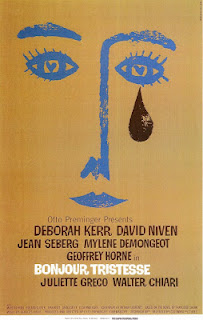August 23rd: BONJOUR TRISTESSE (Otto Preminger, 1958)
A girl living with her playboy father on the French Riviera feels their lifestyle threatened with the arrival of a family friend.
Producer-director Otto Preminger was born in then Austria-Hungary, and after growing up in Vienna began apprenticing with legendary theatre director Max Reinhardt. He soon struck out on his own, directing plays himself, and eventually caught the attention of Hollywood representatives, and signed a contract with 20th Century Fox. A dispute with studio head Darryl F. Zanuck left him temporarily out of work, but after time in the New York theatre scene he made a triumphant return with the film noir classic Laura.
For the next 10 years Preminger would prove adept at alternating between noirs and period/literary dramas, often working with the studio's big stars. In the mid-1950s, he would become an independent producer, choosing his own material and often challenging the official Hollywood censors with controversial subject matter. His colorful interview/promotional persona helped to brand his films akin to Alfred Hitchcock's stature, along with his recurring use of title and poster designer Saul Bass.
For his adaptation of George Bernard Shaw's play Saint Joan, Preminger sought to cast an unknown as his lead, looking at thousands of aspiring actresses. He selected Jean Seberg, an 18 year-old who had only done Summer Stock theatre to this point. Preminger wanted to mold Seberg into a star and used cruel, exhausting techniques to break down her resistance and spirit. Despite the eventual commercial and critical failure of the film, he stubbornly brought her along for his next feature, an adaptation of the French bestseller Bonjour Tristesse, whose author Françoise Sagan was also only 18
when she wrote the book.
The film was partially shot on location in Saint Tropez on the Riviera, with additional shooting on soundstages in London. Behind the camera was French veteran cinematographer Georges Périnal (The Life and Death of Colonel Blimp. In addition to Seberg, the cast includes British actors David Niven (The Pink Panther, Preminger's The Moon is Blue) and Deborah Kerr (From Here To Eternity, The King & I), as well as French actress Mylène Demongeot.
Shot primarily in Technicolor, Preminger occasionally intercuts his warm, sun-drenched Riviera footage with a sobering black & white framing story. His favored use of wide Cinemascope long takes allow the viewer to study the relationships between the characters.
When the film was released to mixed reviews and indifferent box office returns, Preminger pushed ahead without his young protege. Seberg would remain in France until a meeting with film critic Jean-Luc Godard resulted in his directorial debut Breathless, turning both into international cinema icons.
Running time is approx. 90 minutes.










Comments
Post a Comment